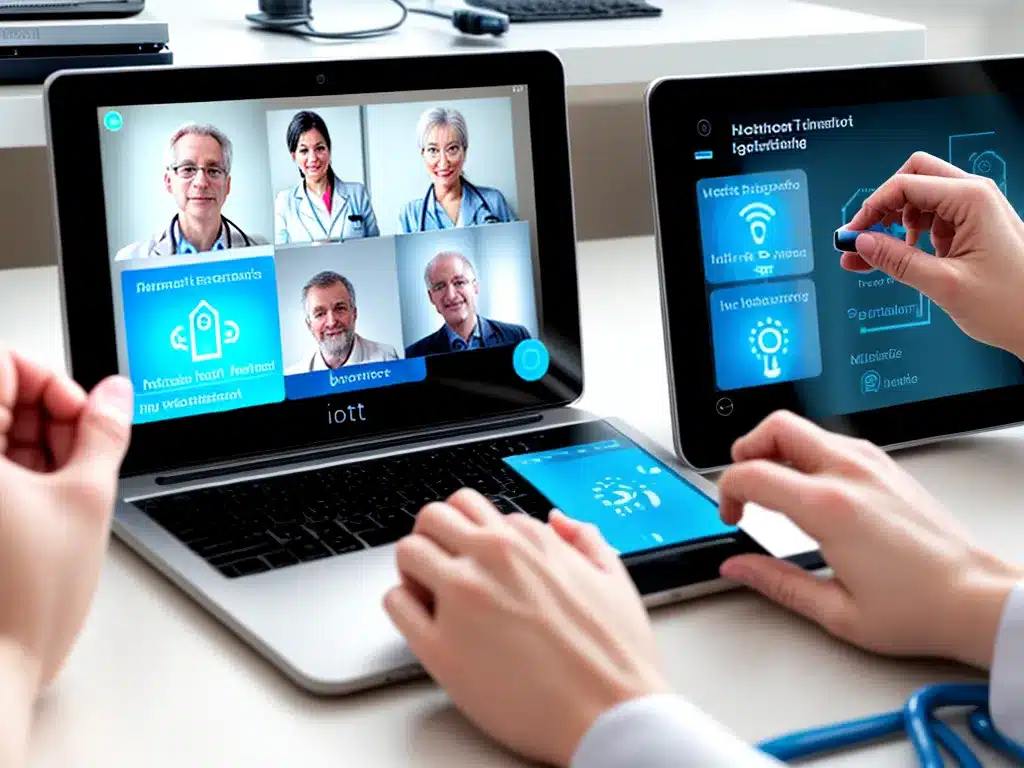IoT in Healthcare: Telemedicine and Remote Monitoring
Introduction
The Internet of Things (IoT) is transforming healthcare by enabling remote monitoring and telemedicine. These technologies allow medical professionals to monitor patients and provide care from afar, improving access and outcomes. In this article, I will provide an in-depth look at how IoT is enabling telemedicine and remote patient monitoring in healthcare.
What is Telemedicine?
Telemedicine is the use of digital communication technologies to provide healthcare remotely. It allows patients to connect with doctors through video conferencing, mobile apps, and other tools.
Some examples of telemedicine include:
-
Virtual doctor visits – Patients can consult with physicians through live video chat instead of going to the doctor’s office. This makes care more convenient.
-
Remote patient monitoring – Doctors can monitor patients’ vital signs and symptoms outside of the clinic using connected devices and software. This allows for regular care without requiring in-person visits.
-
Specialist e-consultations – Primary care doctors can consult remotely with specialists when they need input on a patient’s case. This improves access to expert opinions.
-
Medical education – Telemedicine technologies enable educational opportunities for both patients and providers. Doctors can participate in remote training sessions.
The main benefits of telemedicine include increased access to care, convenience, and lower costs. It allows patients in rural or underserved areas to get quality care. It also enables home monitoring for chronic conditions, reducing hospital visits.
IoT Enabling Remote Patient Monitoring
IoT devices and sensors play a major role in enabling remote patient monitoring. Here are some examples:
-
Wearable devices – Fitness trackers and smartwatches can continuously measure vital signs like heart rate and sleep patterns. They can sync data via Bluetooth with smartphones. Doctors can access this data to monitor patients.
-
At-home health devices – Connected blood pressure cuffs, scales, glucometers and more allow patients to easily track vitals at home. Data integration platforms aggregate this information for provider access.
-
Mobile health apps – App-connected devices and symptom trackers allow patients to log health data. Doctors can analyze this data to monitor chronic conditions and watch for concerning changes.
-
Implanted sensors – Next-generation implants like smart pacemakers can wirelessly send cardiac data to providers without requiring office visits.
-
Smart medication dispensers – These devices can automatically dispense medications and send usage data to clinicians to improve adherence monitoring.
The key benefit of remote monitoring is that doctors can access frequent, real-time patient data without requiring office visits. This enables early intervention and improves chronic disease management.
Telemedicine Monitoring Improving Patient Care
Telemedicine and remote monitoring are enhancing several aspects of patient care, including:
Chronic Disease Management
-
Remote monitoring enables regular care for chronic conditions like diabetes and hypertension without frequent clinic visits. Connected devices track vitals, allowing doctors to watch for red flags.
-
For example, blood glucose readings and weight data help optimize insulin levels for diabetes patients. High blood pressure can be controlled through medication adjustments based on home monitoring data.
-
This approach helps avoid complications and hospitalizations. It also empowers patients to self-manage their conditions at home through IoT-enabled care.
Post-discharge Monitoring
-
Recently discharged patients are at high risk for complications and readmissions. Remote monitoring allows closer follow-up.
-
Doctors can regularly check symptoms like pain levels, respiratory rate, and swelling. Patients can easily report concerns through telemedicine apps.
-
Early intervention is possible when emerging problems are detected through connected monitoring devices. This improves recovery and avoids costly readmissions.
General Wellness & Preventive Care
-
Wearable health trackers allow patients to monitor wellness indicators like physical activity, sleep, heart rate variability, and respiratory rate.
-
This fosters health consciousness and helps people make lifestyle improvements. It also aids doctors in looking at overall wellness patterns.
-
Remote monitoring ultimately enables more preventive care. Issues can be addressed early before they require extensive treatment.
The Future of Telemedicine & Remote Monitoring
IoT-enabled telemedicine and remote monitoring are set to become integral components of healthcare delivery. Here are some upcoming innovations in this space:
-
Advances in wearables & sensors – Smaller, more advanced miniaturized sensors will enable continuous, seamless health data collection. Novel biomarkers like blood pressure and glucose monitoring without needles/strips will emerge.
-
5G networks & improved data analytics – High-speed 5G networks will enable real-time health data transmission from anywhere. Better analytics will find insights in complex medical datasets.
-
Smart home medical devices – Household appliances like smart toilets will double as diagnostic tools, tracking biomarkers in waste. Wall-mounted scanners will measure vital signs using computer vision.
-
AI-assisted telemedicine – AI assistants will screen patients, process paperwork, schedule visits, recommend care plans, and more – improving access and efficiency.
-
Augmented/virtual reality applications – AR/VR tools will enhance telemedicine with immersive 3D anatomy visualization and physician-guided remote treatments.
-
Blockchain integration – Blockchain technology will ensure health data privacy and security as information exchange increases.
Conclusion
In summary, IoT-enabled telemedicine and remote monitoring are transforming healthcare by providing care from a distance. Connected devices track patient data, allowing doctors to intervene early before conditions worsen. This increases access, reduces costs, and improves outcomes. As sensor technology, networks and analytics continue to advance, telemedicine will become a pillar of healthcare delivery. The future looks bright for using IoT connectivity to provide convenient, proactive and patient-centered care.













